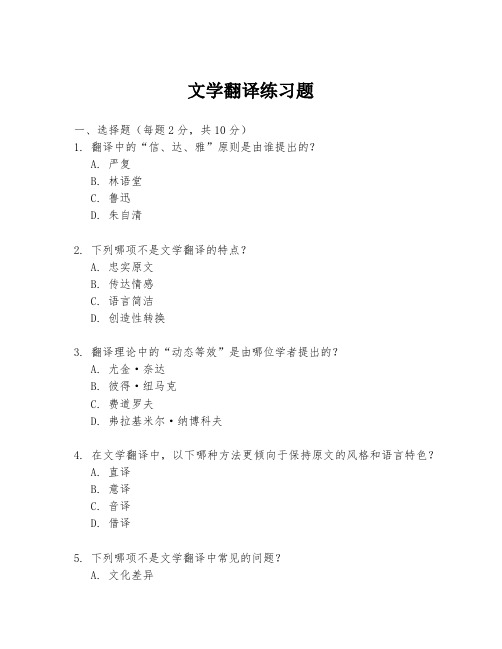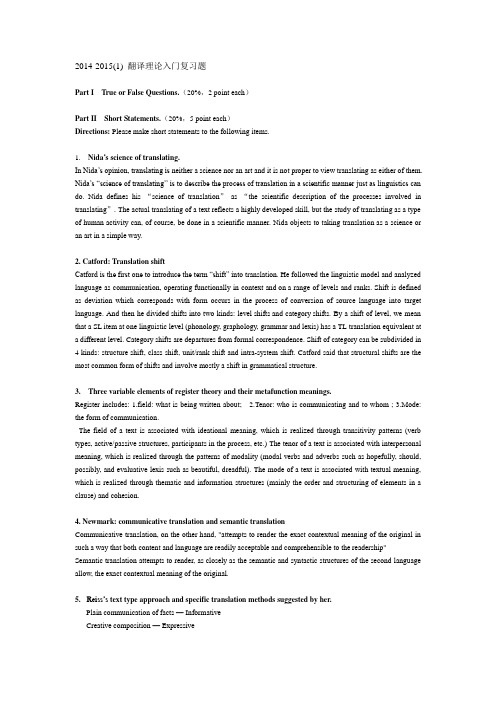翻译理论的习题及答案
- 格式:doc
- 大小:14.00 KB
- 文档页数:3

英语翻译专项习题及答案解析含解析一、高中英语翻译1.高中英语翻译题:Directions:Translate the following sentences into English, using the words given in the brackets.1.晚上别喝太多的咖啡,会睡不着觉的。
(or)2.事实证明,保持快乐的心态会降低得心脏病的风险。
(It)3.乐观的人不会过分怀念美好的旧时光,因为他们正忙着创造新的回忆。
(create)4.追求稳定并不是什么坏事,很多时候这样的态度在促使我们提升自我、挑战难度、攀登高峰。
(when)【答案】1.Don’t drink too much coffee at night, or you won’t be able to sleep.2. It is proved that keeping a happy mind reduces the risk of heart diseases. 3.Optimistic people don’t miss the good old days too much, because they are busy creating new memories.4. The pursuit of stability is not a bad thing. (and) There are many times when such an attitude drives us to improve ourselves, challenge difficulties, and climb peaks.【解析】【分析】本题考查翻译,用括号所给的词将中文翻译成英文。
翻译要注意句子的时态和语法的运用。
1.考查祈使句。
祈使句 + and/or,前面的祈使句表示条件,or或and引导的分句表示结果这里表示转折关系,故用or。
故答案为Don’t drink too much coffee at night, or you won’t be able to sleep.2.考查名词性从句。

第一章翻译概论p.212 练习题二(1)部分地由于日益增长的需求,批发茶价已翻了几乎一番。
(2)我读到他的信又惊又喜,惊的是他还健在,喜的是他一直没有忘记我。
(3)如果我爸爸知道此事,他一定会气得从棺材里跳出来。
(4)史密斯太太也容光焕发,第一次狼吞虎咽地大口吃饭,像一只小猪。
(5)青春并非人生的一段时间,而是一种心态。
它不仅表现于满面红光,嘴唇红润,腿脚灵便,更意味着坚强的意志,卓越的想象力和充沛的情感。
(6)她再也不愿意相信任何男人了。
(7)昨夜我听见他鼾声如雷。
(8)他又想呆在家里看电视连续剧,又想和她一起去看电影,一时觉得分身无术。
(9)我们先看看礼拜天上午有没有空,到时再考虑能否接受你们的邀请。
(10)读书足以怡情,足以博彩,足以长才。
其怡情也,最见于独处幽居之时;其博彩业,最见于高谈阔论之中;其长才也,最见于处世判事之际。
第六章第一节练习题答案(1)Their brand is gaining in popularity.(2)No spitting.(3)The man living on welfare began to build up his own market, one step at a time.(4)He has a loose tongue.(5)We should make full use of the platform to strengthen communication.(6)He is henpecked.(7)An image of being close to the people can get a new policy more easily accepted.(8)He needs to improve the art of leadership.(9)The mayor has decided to look into the affair in person.(10)He shot at the birds, but they flew away.(11)He hit upon a good method to speed up the progress of the experiment. (12)We grade the students according to their reading ability.(13)No one was certain whether he postponed the visit on purpose.(14)People’s quality of life has been improving.(15)Even Beethoven’s father discounted the possibility that his son would one day become the greatest musician in the world.第六章第二节练习题答案(1)All one’s geese are swans.(2)Broken bones well set become stronger. (3)Talk of the devil and he will appear.(4)Beauty is in the eye of the beholder. (5)Love me, love my dog.(6)Turn over a new leaf(7)A fly in the ointment(8)All roads lead to Rome.(9)A flying visit(10)Break a butterfly on a wheelWeek 3 课堂练习及答案重译法课堂练习:(1)Translation from English into Chinese is not as easy as that from English intoFrench.英译汉不如英译法容易。

翻译概论课后参考答案 Document number:PBGCG-0857-BTDO-0089-PTT1998翻译概论课后习题答案第二章P41-1? 试对中西传统译论作进一步研究和比较,并指出其异同之处。
西方(1)公元前46?年,罗马帝国时期的西塞罗撰写了《论最优秀的演说家》中区分了翻译的两种基本方法——直译和意译,堪称西方译论之源。
(2)公元380?年圣哲罗姆的翻译集所作的序中,认为对词序、文采、辞格、韵味的处理存在着客观上的困难。
(3)文艺复兴时代的法国翻译家艾蒂安·多莱在1540年发表了《论佳译之方法》提出了五条翻译原则,都是从怎么译的角度来探讨翻译的。
(4)德国马丁·路德提出翻译的七条细则。
(5)以翻译《伊利亚特》与《奥赛德》而驰名译坛的英国翻译家乔治·查普曼提出了具体的译诗的原则。
中国?(1)陈福康将中国传统译学理论的发展分为古代、晚清、民国、1949?年以后四个时期。
(2)三国时支谦写的《法句经序》主张的翻译方法“因循本旨,不加文饰”。
(3)东晋、前秦时期的高僧、翻译家道安的“五失本”、“三不易”。
(4)张思洁在《中国传统译论范畴及其体系》一书中所言,自《法句经序》起,中国传统翻译思想大略经历了形成、转折、发展和鼎盛四个阶段。
(5)罗新璋从张思洁的长轴中理出四个概念,高度概括了传统译论的历程:“案本—求信—神似—化境”。
(6)王宏印对中国传统译论有五个特点:“一、以道德为本位,强调译者道德修养和敬业从业为本的主体性意识。
二、服务公众和社会的群体本位思想。
三、人文主义的语言观而不是科学主义的语言观,始终是中国传统翻译实践的潜在的理论导向。
四、人文社科类作为主要文本翻译的类型,在材料内容、语言类型和运思方式上都倾向于文学翻译的艺术性,而不是科学翻译的科学性。
五、哲学的而非科学的,美学的而非宗教的,是中国传统译论的始终如一的理论基础。
异:中西方翻译理论译者的主体意识与客体意识。

文学翻译练习题一、选择题(每题2分,共10分)1. 翻译中的“信、达、雅”原则是由谁提出的?A. 严复B. 林语堂C. 鲁迅D. 朱自清2. 下列哪项不是文学翻译的特点?A. 忠实原文B. 传达情感C. 语言简洁D. 创造性转换3. 翻译理论中的“动态等效”是由哪位学者提出的?A. 尤金·奈达B. 彼得·纽马克C. 费道罗夫D. 弗拉基米尔·纳博科夫4. 在文学翻译中,以下哪种方法更倾向于保持原文的风格和语言特色?A. 直译B. 意译C. 音译D. 借译5. 下列哪项不是文学翻译中常见的问题?A. 文化差异B. 语言障碍C. 语法结构D. 词汇量不足二、填空题(每题2分,共10分)6. 翻译理论中的“______”是指在翻译过程中,译者应尽量使译文读者获得与原文读者相同的阅读效果。
7. 在翻译中,处理文化差异的一种方法是“______”,即在译文中加入适当的解释或注释,帮助读者理解原文中的文化元素。
8. 翻译中的“______”是指译者在翻译过程中对原文进行适当的调整,以适应目标语言的文化和语言习惯。
9. 翻译中“______”的原则要求译者在忠实原文的基础上,尽可能使译文流畅自然,符合目标语言的表达习惯。
10. “______”是文学翻译中一种常见的技巧,通过增加或省略某些信息,使译文更加贴近目标语言读者的阅读习惯。
三、简答题(每题10分,共20分)11. 简述文学翻译中“忠实性”与“创造性”的关系。
12. 举例说明在文学翻译中如何处理文化差异。
四、翻译实践题(每题15分,共30分)13. 将以下句子从中文翻译成英文,并注意保持原文的文学韵味。
- 春风又绿江南岸,明月何时照我还?14. 将以下英文句子翻译成中文,并注意传达原文的情感色彩。
- The leaves were green, the grass was lush, and theflowers were blooming in a riot of colors.五、论述题(共30分)15. 论述文学翻译中如何处理原文的修辞手法,以保持译文的文学性和艺术性。

2014-2015(1) 翻译理论入门复习题Part I True or False Questions.(20%,2 point each)Part II Short Statements.(20%,5 point each)Directions: Please make short statements to the following items.1. Nida’s science of translating.In Nida’s opinion, translating is neither a science nor an art and it is not proper to view translating as either of them. Nida’s “science of translating’’ is to describe the process of translation in a scientific manner just as linguistics can do. Nida defines his “science of translation”as “the scientific description of the processes involved in translating”. The actual translating of a text reflects a highly developed skill, but the study of translating as a type of human activity can, of course, be done in a scientific manner. Nida objects to taking translation as a science or an art in a simple way.2. Catford: Translation shiftCatford is the first one to introduce the term “shift” into translation. He followed the linguistic model and analyzed language as communication, operating functionally in context and on a range of levels and ranks. Shift is defined as deviation which corresponds with form occurs in the process of conversion of source language into target language. And then he divided shifts into two kinds: level shifts and category shifts. By a shift of level, we mean that a SL item at one linguistic level (phonology, graphology, grammar and lexis) has a TL translation equivalent ata different level. Category shifts are departures from formal correspondence. Shift of category can be subdivided in4 kinds: structure shift, class shift, unit/rank shift and intra-system shift. Catford said that structural shifts are the most common form of shifts and involve mostly a shift in grammatical structure.3. Three variable elements of register theory and their metafunction meanings.Register includes: 1.field: what is being written about; 2.Tenor: who is communicating and to whom ; 3.Mode: the form of communication.The field of a text is associated with ideational meaning, which is realized through transitivity patterns (verb types, active/passive structures, participants in the process, etc.) The tenor of a text is associated with interpersonal meaning, which is realized through the patterns of modality (modal verbs and adverbs such as hopefully, should, possibly, and evaluative lexis such as beautiful, dreadful). The mode of a text is associated with textual meaning, which is realized through thematic and information structures (mainly the order and structuring of elements in a clause) and cohesion.4. Newmark: communicative translation and semantic translationCommunicative translation, on the other hand, "attempts to render the exact contextual meaning of the original in such a way that both content and language are readily acceptable and comprehensible to the readership" Semantic translation attempts to render, as closely as the semantic and syntactic structures of the second language allow, the exact contextual meaning of the original.5.Reiss’s text type approach and specific translation methods suggested by her.Plain communication of facts — InformativeCreative composition — ExpressiveInducing behavioral responses — OperativeAudiomedial textsThe TT of an informative text should transmit the full referential of conceptual content of the ST.The TT of an expressive text should transmit the aesthetic and artistic form of the ST.The TT of an operative text should produce the desired response in the TT receiver.Audio-medial texts require the “supplementary” method.6. Three major cases when translated literature occupies the primary position:1) when a “young” literature is being established and looks initially to “older” literatures for ready-made models.2) when a literature is “peripheral” or “weak” and imports t hose literary types which it is lacking.3) when there is a critical turning point in literary history at which established models are no longer considered sufficient, or when there is a vacuum in the literature of the country. Where no type holds sway, it is easier for foreign models to assume primacy.7. Tytler翻译三原则(译作完全复写原作思想/风格手法与原作同质/具备原作通顺):(一) 译作应完全复写出原作的思想;(二) 译作的风格和手法应和原作属于同一性质;(三) 译作应具备原作所具有的通顺。

一、翻译的基本理论复习题(一)列举至少三种翻译标准(中、西均可),并指出是由谁提出的。
中国的:严复,信雅达三字标准; 林语堂:忠实,通顺,美的标准傅雷,神似;茅盾:意境论;钱钟书:化境秀明:韵味说外国的:泰特勒的三原则(1.译文应完全复写出原作的思想2.译文的风格和笔调应与原文的性质相同3.译文应和原作同样流畅)费道罗夫的等值论:等值即译文和原文等值,表现在读者看了原文和译文之后,其感受的等值性。
奈达的等效理论奈达从社会语言学和语言交际功能观点,提出“最接近的,自然的等效翻译”概念,认为翻译必须以接受者服务为中心,要根据不同接受者的要求对译文作相应调整。
(二)翻译的主要方法有_直译_和_意译_。
“直译”就是忠实的再现原作思想容,并尽量保存原作语言形式的表现方法。
原文如在形、义上与译语全同或是基本相同的可以直译,原语中的比喻或形象能为译语读者所接受的有时也可以采用直译。
“意译”是忠实传达原作思想容而放弃原作形式。
多强调译文的效果,不求表层次形式对应,只求语言在深层次中的对应。
不是主观臆断,是以不背离原文为限度,注意翻译时对原文结构的调整,用规的译语表达。
(三)列举你所掌握的翻译技巧。
技巧是翻译的具体策略,在直译和意译两大类翻译方法之下,具体的翻译技巧有分切、转换、转移、还原、阐释、融合、引申、反转、替代、拆离、增补、省略、重复、重组、移植等。
再概括起来,可以归结为增、减、移、换四大策略。
(四)列举中、西翻译史上著名翻译家至少十位。
傅雷,季羡林,草婴,鲁迅,绛,朱生豪,谷若,诺思,查普曼,费洛里欧,何兰德,阿瑟伟利,弗兰茨库恩,玄奘、义净、徐寿、善兰、元益、卞之琳、叶水夫、黄龙、茅盾;乔叟、西塞罗、哲罗姆、阿尔弗雷德国王、波伊提乌、诺思(五)谈谈翻译的困难(至少两点)。
首先理解的困难。
汉语和英语都是很发达的语言,以表达丰富细致著称,要理解的准确必须处处细致。
Eg:in the seventh heaven不可按表面译为“升天”本意是“非常高兴”:翻译方法的选择是另一困难。
(完整word版)中西翻译简史第1、3、5章部分课后习题答案亲爱的读者:本文内容由我和我的同事精心收集整理后编辑发布到文库,发布之前我们对文中内容进行详细的校对,但难免会有错误的地方,如果有错误的地方请您评论区留言,我们予以纠正,如果本文档对您有帮助,请您下载收藏以便随时调用。
下面是本文详细内容。
最后最您生活愉快 ~O(∩_∩)O ~第一章1.“翻译”的词源学含义给我们带来什么样的启示?(P6)答:从翻译的词源可以看出,(1)印欧语言比其他语言更强调相似性,特别是在早期的宗教典籍翻译中甚至要求一致性。
这也就是为什么在西方的翻译理论中“对等”观念会起到核心作用,而要表示自有翻译时,则会使用其他术语如“改编”的原因。
(2)很多语言中,“翻译”与“口译”使用不同的术语,意味着这是两种完全不同的活动。
“口译”比“翻译”更强调“调停”。
(3)不同的语言对翻译观念的阐释方式也不同,并非所有的阐释都像印欧语言中那样强调保存同一性。
斯特科尼提出翻译的符号学特征具有三个方面共性:相似性,差异性与调停。
这些共性可以看作是所有翻译都具有的特征,但“翻译”一词的确切含义不是预先给定,一劳永逸的,也不是不证自明的,它需要在对历史上翻译过程与翻译结果的研究中去发现。
3、三大宗教典籍的翻译存在哪些差异?答:(1)《圣经》是世界上印数最多、发行最广、翻译语种最多的书籍,也是被联合国工人为对人类影响最大、最深的一本书。
对西方社会的精神信仰和行为方式影响尤其巨大,与希腊神话同为打开西方精神世界的钥匙。
《圣经》除了是一本宗教典籍之外,它本身还是一部重要的文学作品,它的一本几乎是欧洲大多数民族语言的第一范本。
阅读《圣经》各种一本的人如此之多,甚至连研究它的著作也是汗牛充栋,以至于形成了一种专门的学问,即“圣经解释学”。
(2)印度佛经原无写本,初期翻译主要靠外来僧人凭记忆口授。
译者受中国传统宗教尤其是道家“得道成仙”观念的影响,往往是以道家的哲学名词,概念来比附佛学。
翻译练习题含答案及分析一、高中英语翻译1.高中英翻:Translate the following sentences into English, using the words given inthe brackets.1.个家所介绍的方法被明是十分有效的。
(prove)2.国家来,保生境和保持增同重要。
(as...as)3.假如有朝一日,学生能自参加到程开中,那有多棒啊!(involve)4.本新行的志不会影响青少年尚的见解,会开启健康食的新潮流。
(Not only)【答案】1.The method recommended by the expert proved (to be) very effective.2.For/To a country, protecting the environment is as important as maintaining economic growth.3.How great it is if one day students can be involved in the development of courses on their own.4.Not only will the newly-released magazine influence teenager's opinions on fashion, but alsoit will start a new trend towards a healthy diet.【分析】【剖析】本考翻句子,注意按括号内的要求翻。
1.考非和prove 的用法。
The method 与 recommend 之是上的关系,表示被,用去分作后置定,prove用作系,prove(to be)+adj表示“(被)明是⋯⋯的”,境表示事情生在去,用一般去,故翻:The method recommended by the expert proved (to be) very effective2.考非和 as...as 的用法。
翻译理论练习题西方译论简介西塞罗:“我不是作为解释员而是作为演说家进行翻译的,不是字当句对,而是保留语言的总的风格和力量。
”泰特勒的“翻译三原则”: 1) 译文应完全传达原作的思想; 2)译文的风格与笔调应与原作属于同一性质;3)译文应具有原作的流畅性。
费道罗夫的等值翻译思想: 1)与原文作用相符(表达方面的等值); 2) 译者所选用的语言材料的等值(语言和文体的等值)奈达的翻译思想:所谓翻译,是指用一种语言中的语言符号解释另一种语言中的语言符号;是指从语义和文体风格上采用最接近而又最自然的同义语再现原文的信息。
他主张把翻译的重点放在译文读者的反应上。
他认为判断译作是否翻译得正确,必须以译文的服务对象为衡量标准。
“衡量翻译质量的标准,不仅仅在于所译的词语能否被理解,句子是否合乎语法规范,而在于整个译文使读者产生什么样的反应。
”英国翻译理论家:纽马克(Peter Newmark)他提出真正的翻译应该充分体现作者的意图。
译者应忠实于原文读者和译文,并根据原文所使用的语言种类来确定原文读者群的特点,从而确定给予目的语读者多少注意力。
西方翻译理译理论练习题1. It is _______ that wrote Essay on the Principles of Translation in 1790.A. F. TylerB. Charles R. TaberC. Saint JeromeD. Eugene A. Nida2. According to The Art of Translation by Theodore Savory, faced with a passage in its original language, a translator must ask himself some questions except: A. What does the author say? B. What does he mean? C. How does he say it? D. Why does he say it? 3. The Art of Translation is written by _______. A. Theodore Savory B. George Steiner C. Eugene A. Nida D. Charles R. Taber4. Several thousand years ago, _______ did not think it necessary to translate word for word, and he preserved the general style and force of the language. A. Cicero B. Saint Jerome C. John SteinbeckD. Theodore Savory5. All of the following ideas are Cicero’s, except ________. A.It wasn’t necessary to translate word for word.B.He preserved the general style and force of the language.C.It wasn’t his duty to count out words to the re ader like coins, but rather ti pay them out by weight as it were.D.He aimed at translating sense, not words.6. A. F. Tytler thought the principles of translation included all the following except _______. A. the translation should give a complete transcript of the ideas of the original work. B. It is necessary to translate word for word. C. The style and manner of writing should be of the same character with that of the original. D. The translation should have all the ease of original composition.7. “______” is the idea of Saint Jerome. A.It isn’t necessary to translate word for word. B.I have always aimed at translating sense, not words. C.The translation should have all the ease of original composition. D.The style and manner of writing should be of the same character with that of the original.8. ________ is correct. A.Saint Jerome said that he had always aimed at translating sense, not words. B.Saint Jerome said that it was necessary to translate word for word. C.Saint Jerome said that it wasn’t his duty to count out words to the reader like coins, but rather to pay them out by weight as it were. D.ASaint Jerome said that he preserved the general style and force of the language when he was translating.9. ________ describes a good translation to be, that, in which the merit of the original work is so completely transfused into another language, as to be as distinctly apprehended, and as strongly felt, by a native of the country to which that language belongs, as it is by those who speak the language of the original work. A. Cicero B. Saint Jerome C. A. F. Tylter D. Charles R. Taber 10. 句法上下文是指——————。
华中师大学网络学院《翻译理论与技巧》练习测试题在下列句中空白处填上合适的词语。
每空1分。
共10分。
1.翻译是跨()、跨()、跨()的交际活动。
2.篇章的粘连分()粘连和()粘连两大类,粘连的目的是实现篇章的()。
3.社会符号学的翻译标准是()相符、()相似。
4.格赖斯的()原则和利奇的()原则是促使语言交际成功的语用原则。
5.社会符号学翻译法以礼德所述的语言的社会符号性为根据,以符号学的意义观为核心。
语言符号具备三种意义,它们是()意义、()意义和()意义。
6.语言对比是研究语言在()中产生的意义。
7.泰特勒在《翻译的原则》一书中提出了著名德三原则:A.译文应完整地再现原文的()。
8.译文的()()应与原文的性质相同。
C.译文应像原文一样()。
9.汉语语法呈()性,英语语法呈()性。
10严复的三字翻译标准是、、。
11.鲁迅认为翻译标准可以用和这四个字来表示。
12.翻译的过程是、和。
13.英语翻译成汉语时,英语称之为,汉语称之为。
14.翻译按其工作方式来分,有三种。
15.许渊冲提倡文学翻译要做到、和。
16.在译文语言条件许可时,在译文中既保持原文的容,有保持原文的形式一特别是保持原文的比喻、形象和民族地方色彩等,这种译法叫做。
17.把原文中两个或两个以上的简单句译成一个单句是法。
18.翻译按其处理方式来分,有、和。
19.翻译是“从语义到文体在译入语中用最()而又最()的对等语再现原语的()。
”20.从翻译的手段来看,翻译可分为()、()和()。
21.鲁迅先生认为:“凡是翻译,必须兼顾两面,一当然力求其(),一则保存着原作的()。
”22.由于文化上的差异,英译汉时有时直译原文就会使译入语读者感到费解,甚至误解。
这时,就有必要借用汉语中意义相同或相近、且具有自己文化色彩的表达法对原文加以()。
23.傅雷先生认为:“以效果而论,翻译应当像临画一样,所求的不在(形似)而在()。
24.钱钟书先生提出:“文学翻译的最高标准是()’。
关于翻译理论的习题
选择题
1、直译保存了原作____,因而能达到与原文近似的效果。
A内容B思想C风格D手法
2、死译只注意保存原文____,对原文使用的词语,句子结构,比喻以及其他修辞手法,尽量原封不动地照搬过来。
A 形式B风格 C 意义 D 内容
3、译文中若出现译语词不搭配的现象,就会产生_____。
A 翻译调B翻译病 C 翻译症D翻译腔
4、克服翻译症的方法之一是弄清_____与内容的关系。
A 形式B风格C意义D表面
5、从实用翻译理论的角度来看,译文不但要保存原作的思想风格,而且必须符合译语习惯,即提高____。
A随意性B传意性C相似性D可接受性
6、有的动物可通过动作,如蜜蜂的舞蹈,来传递某种信息,这属于_____。
A自然信息B动物信息C 非语言信息D语言信息
7、交流思想通过语言进行,因而语言是交流思想的___
A物质B工具C媒介D手段
8、有人认为翻译外国小说等文学作品。
三分靠____,七分靠____。
A外语,汉语B汉语,外语C外语,外语D汉语,汉语
9、翻译症的主要特征是____。
A文从句顺B流畅易懂C声情并茂D文笔拙劣
10、不可以的情况有___
A没有对等词B内容和形式必须兼顾的情况C词外含义D A,B and C
1-5 DACAD 6-10 BCBAD
简答题
1、结合具体事例你谈谈对“英语重形合,汉语重意合”这句话的理解。
形合指句子内部的链接或句子间的连接采用句法手段或词汇手段,意合指句子内部的链接或句子间的连接采用语义手段。
印欧语言重形合,语句各成分的相互结合常用适当的链接词语或各种语言链接手段,以表示其结构关系。
汉语重意合,句子各成分之间或句子之间的结合多依靠语义的贯通,少用连接语,所以句法结构形式短小精悍。
2、有人认为翻译的总体发展趋势是由归化逐步趋向与异化,你是否赞同这个观点?
归化与异化作为翻译两种主要的翻译方法,一直是翻译界研究和争论的焦点之一。
归化指以目的语文化为归宿,要求译者向目的语读者靠拢,采取目的语读者所习惯的表达方式,来传达原文的内容。
异化指以源语文化为归宿,要求译者向作者靠拢采取目的语读者所习惯的表达方式来传达原文的内容。
从翻译史来看,是采用归化还是异化的方法,是由当时的社会、文化、
政治及读者审美情趣,接受能力等多种因素所支配。
随着全球经济一体化进程的加速,我国在各个领域对外交流日益频繁,不同文化间的相互兼容性也越来越大,从这个角度来说,翻译方法将越来越趋于异化。